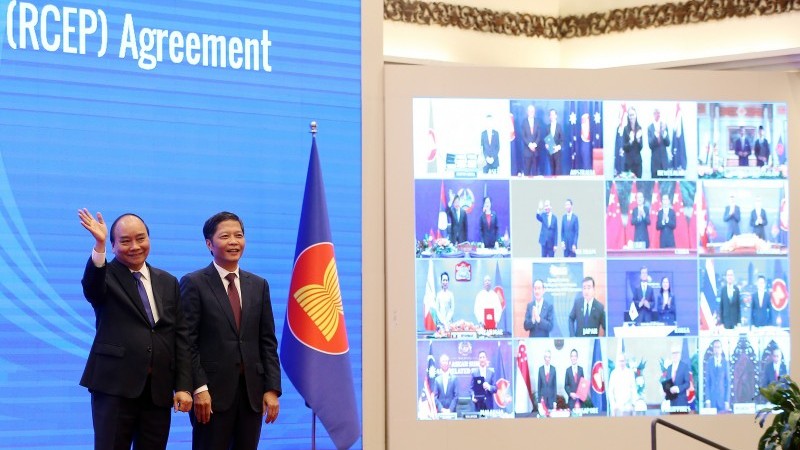Three Short-term Effects Of Asia’s Largest Trading Deal
The recently signed RCEP trade deal is expected to eliminate a range of tariffs on imports within 20 years, but what does that mean in the short run?

Vietnam's Prime Minister Nguyen Xuan Phuc (L) and Minister of Industry and Trade Tran Tuan Anh (R) cheer after the virtual signing ceremony for the Regional Comprehensive Economic Partnership (RCEP) in Hanoi, Vietnam, 15 November 2020
Three important effects of RCEP
The Regional Comprehensive Economic Partnership or RCEP is a new trade agreement between 10 ASEAN countries in Asia Pacific, along with China, Japan, South Korea, Australia and New Zealand. The agreement replaces existing trade agreements between ASEAN countries and the other five countries. It also brings China and Japan, and South Korea and Japan, into trade agreements together for the first time.
Although, RCEP will take time to come into force, with ratification in each country yet to be completed, but the primary aim is to reduce tariffs on imports within 20 years. Admittedly, that is a long time and raises the question of the short-term relevance of this trade agreement if any at all.
But we think, three important impacts are likely to be felt quite quickly.
1) A well-timed boost for free trade
This trade agreement sends an important signal that could be more powerful than actually reducing the import tariffs.
RCEP is a vote in favour of free trade after years of rising frictions - and some of the deal’s own signatories could do with this message: China and Australia came to the table to sign RCEP, but have been exchanging threats to restrict imports of key products.
Countries outside the newly-formed trade bloc may be given pause for thought about the costs of their own trade barriers – especially India, which was initially part of the negotiations but left the table in 2019. Though it was never part of the talks, the US now stands outside of two major trade blocs in Asia-Pacific, having quit negotiations for a Trans-Pacific Partnership deal. These talks evolved into the 2018 CPTPP deal between many of the RCEP countries (Australia, Brunei, Japan, Malaysia, New Zealand, Singapore, Viet Nam) and Canada, Mexico, Chile and Peru.
2) Tackling trade costs
Although the countries in the agreement account for nearly 30% of world output, trade flows between the 15 countries account for around 12% of world trade – larger than the CPTPP and NAFTA’s replacement, the USMCA.
This share could grow further if the deal can make a meaningful difference to regional trade costs, which are relatively high.
Trade between RCEP countries has the potential to grow

Source: UNCTAD, ING
Trade costs between RCEP countries have proved stubbornly high despite the patchwork of trade agreements already in place.
For example, the costs relating to the combination of tariffs and non-tariff barriers between Lao PDR and Brunei are more than eight times higher than the costs of trading these goods within the countries' borders. Also, trade costs between Thailand and New Zealand are double the costs of selling the goods in their domestic markets.
RCEP should help to lower trade costs
Additional costs of international trade relative to domestic trade, %

As a free trade deal, tariff reductions are an important part of RCEP, but the deal should also focus minds on non-tariff barriers between RCEP countries in anticipation of the opportunities ahead. For one, the deal will create a large market for goods produced to the same standards, helping ASEAN producers currently producing different specifications for China, Japan and Korea.
At the border, new rules of origin requirements will treat RCEP countries as equals with regard to qualifying for zero tariffs. And an alternative mechanism will qualify goods if they have been transformed into a different tariff code in an RCEP country. Times for border compliance procedures in some RCEP countries currently rank among the longest in the world, so there are significant potential gains from streamlining administration.
3) Intra-Asian trade flows matter for global supply chains
Trade between RCEP countries forms some of the early links in supply chains that go beyond the region, including electronics and textiles exports to Europe and the US. A reduction in trade costs could benefit resilience in supply chains by making it cheaper (and more feasible) for suppliers to substitute inputs.
Disclaimer: This publication has been prepared by ING solely for information purposes irrespective of a particular user's means, financial situation or investment objectives. The information ...
more


